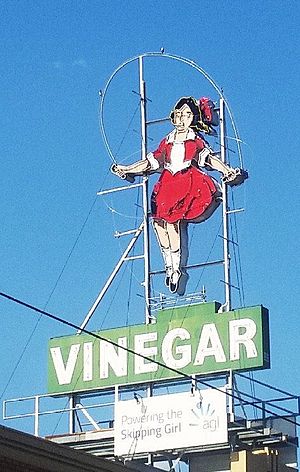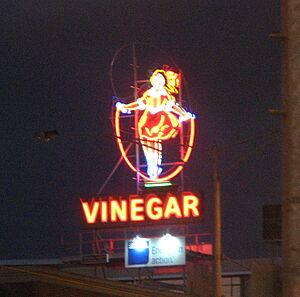Skipping Girl Sign facts for kids
The Skipping Girl Sign is a famous animated neon sign in Melbourne, Australia. People often call it Little Audrey. This sign shows a girl skipping rope and was probably Australia's first animated neon sign when it was put up in 1936. It used to advertise Skipping Girl Vinegar.
The original sign was on top of a factory in Abbotsford. After it was taken down in 1968, people missed it a lot. So, a new version was built and placed on a nearby factory in 1970.
Contents
How the Sign Works
The Skipping Girl Sign is made of metal painted with the girl's shape. Neon lights outline her. At night, these lights glow. The skipping rope lights up in four different steps. This makes it look like the girl is actually skipping!
The First Skipping Girl Sign
Skipping Girl vinegar was made by a company called Nycander & Co. This company was started by Oscar Emile Nycander, who was from Sweden. He created Australia's first yeast factory and vinegar brewery.
The first sign was designed in 1936 by an artist named Jim Minogue. His company, Electric Signs, built and looked after the sign. Nycander & Co paid them rent each year. The sign quickly became a popular landmark in Melbourne.
The idea of a skipping girl with vinegar came from a skipping rhyme. Kids would often say, "salt, vinegar, mustard, pepper," while skipping. In 1938, the company even held a skipping competition for girls to promote their vinegar.
Why the Sign Was Removed
In the 1950s, another company took over Nycander & Co. The Abbotsford factory closed in the mid-1960s. When the building was pulled down in 1968, the sign was removed too. A demolition company claimed the sign and sold it to a used car dealership.
The New Sign in the 1970s
Many people were upset that the sign was gone. John Benjamin, who owned a nearby factory called Crusader Plate, decided to help. He worked with the local council to get the sign back.
Since the original sign was sold, a new, slightly smaller version was built. This new sign was put on the roof of Crusader Plate's factory in 1970. This 1970 sign is now very important. It was listed by the National Trust of Australia in 2000 and is also on the Victorian Heritage Register.
The sign lit up every night until 2002. Then, the building owners decided they could no longer pay for the electricity and upkeep.
Bringing Little Audrey Back to Life
In May 2008, a group called 'Friends of Audrey' started asking for donations to fix the sign. The National Trust of Australia helped with this appeal. An energy company, AGL Energy, ended up paying for most of the repairs, electricity, and ongoing maintenance. In return, AGL got to put an advertisement at the bottom of the sign.
Little Audrey was taken down for repairs on March 23, 2009. She was put back up on June 10 of the same year. In 2012, AGL announced that the sign would be powered by 27 solar panels on the roof. This uses their 100% GreenPower energy plan, which is good for the environment.
The Building's Future
In February 2020, news reports said that the factory building where the sign sits was being sold. There are rules about how tall new buildings can be in that area. However, because the building is heritage listed, it might get extra floors. This could mean the Skipping Girl Sign would need to be moved even higher up.
How the Sign Inspired Others
The Skipping Girl Sign has inspired many artists and musicians:
- In 1973, the song "Skipping Girl" by Barry Humphries was sung by Shirley Jacobs.
- The sign appeared in the 1987 TV movie 'Bachelor Girl'.
- Australian artist Howard Arkley included the sign in his 1983 painting, which he called ... (1983). He said the sign reminded him of his childhood.
- When Melbourne's Southbank opened in 1992, an art piece called 'Running Girl' was put on a bridge. It was a modern version of 'Little Audrey'.
- A Melbourne indie pop band called The Killjoys named their 1988 cassette "Audrey" and featured the sign on its cover.
- Another Melbourne indie pop group, Skipping Girl Vinegar, named themselves after the sign. They said they loved her as a "pop icon" of Melbourne.
- The band My Friend the Chocolate Cake also mentioned the sign in their song "It's All in the Way."
- On September 1, 2015, the Skipping Girl Sign was featured on an Australia Post stamp. It was part of a series called "Signs Of The Times."
Other Famous Australian Signs
- Borsari's Corner in Carlton, Victoria
- Dingo Flour sign in North Fremantle, Western Australia
- Nylex Clock in Cremorne, Victoria
- Pelaco Sign in Richmond, Victoria



